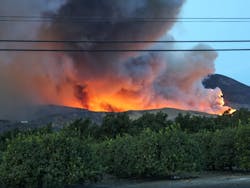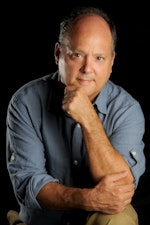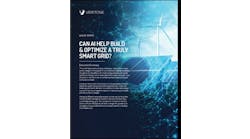A little more than a year ago, California’s Ventura and Santa Barbara counties suffered from a month-long fire that destroyed 1,000 structures. And a month later, in January 2018, heavy rains drenched the hillsides and caused mudslides, all in the same general area. Twenty-three lives were lost, not to mention the loss of 100 homes.
Altogether, the so-called Goleta Load Pocket spans 70 miles along the coastline and encompasses the jurisdictions of Goleta, Santa Barbara, Montecito and Carpinteria. That area is now grid-dependent, meaning that if harsh conditions cause the power to go out, the whole region feels the impact. Indeed, Southern California Edison (SCE) has said that the area’s transmission system could fail because of fire, earthquake and heavy rains. So what is being done about it?
The Clean Coalition and the World Business Academy are working to create a series of community microgrids, driven by renewables, initially for the city of Montecito. The first stop for the Montecito Community Microgrid Initiative is the city’s fire department, which will still be linked to the main electric grid but will also have a microgrid that can isolate from the grid and generate power for the fire department and participating businesses.
Hear more about the Clean Coalition’s community microgrid plans at Microgrid 2019, May 15 in San Diego. Agenda here.
The microgrid is expected to be completed by the end of the year. After the fire department, the development team plans to connect the city’s water department followed by an elementary school that serves as a shelter during high-impact events. The community microgrid will serve a quarter of the energy consumed in that target area — no matter the day and no matter the weather conditions. In the summer, it could be a great as 40 percent.
“You want to make sure you can keep your critical loads even during the worst weather day,” says Craig Lewis, executive director of the Clean Coalition that is trying to accelerate the transition to renewable energy and a modern grid, in an interview. “The sites will be stand alone microgrids, with additional features that can tie into the existing distribution grid. But the first installations will operate in island mode at customer meters.”
The catalyst
A major catalyst for taking on a project like this was Superstorm Sandy, which wiped out parts of New Jersey and New York in 2012. That prompted Long Island, N.Y. to create a community microgrid. Indeed, the Long Island Community Microgrid Project, located in East Hampton, N.Y., aims to achieve nearly half of its grid-area electric power requirements from solar power. The project doesn’t just decrease grid reliance but it also diminishes the need for fossil-fired generation and it increases the demand for renewable energy.
Onsite generation, of course, feeds electrons into the microgrid during critical periods. The Clean Coalition is confident that renewable energy will assume a commanding position. However, many critical services now use diesel generators as a back-up source of electricity during power outages.
Executive Director Lewis says that diesel is expensive and can be quite difficult to deliver during emergencies; the diesel fuel has to be procured from somewhere. Once the coalition can show that the Montecito Community Microgrid Initiative is effective, it expects the need for back-up diesel generators to wane, although they will not be extracted from any premise.
Priority sites with solar potential for the Montecito Community Microgrid Initiative. Courtesy of the Clean Coalition
“We are excited to explore renewable energy opportunities through a community microgrid approach that will make the Montecito Fire Department and the community more resilient,” said Fire Chief Chip Hickman, in a release. “The Fire Department is all too familiar with the dangers posed by extreme weather events…This modern energy system will enable us to better serve the Montecito community, as well as provide much-needed redundancy to our essential service.”
Initial funding for the Montecito Community Microgrid Initiative came from Kind World Foundation, which created a matching grant of $150,000. A donation by the Zegar Family Foundation brought the project within sight of its initial $300,000 fundraising goal, according to the Clean Coalition. The funding supports the staging of community microgrids in Montecito’s Upper Village, including aligning stakeholders, performing engineering and economic analyses, and identifying investors to leverage tax credits available to the parties that will own the community microgrid assets and sell energy to the sites via power purchase agreements.
SCE has identified these transmission lines as being at risk for catastrophic failure from fire, earthquake, or heavy rains, which would cause a crippling, extended blackout of weeks or even months. Courtesy of the Clean Coalition
A community microgrid model for the US
No doubt, utilities are taking notice of microgrids. In the case of the Montecito project, Lewis says that he must coordinate his activities with SCE that runs the grid in the region. He said that statewide legislation has foisted this concept upon the state’s utilities and that they are still getting used to it. But he quickly says that distributed energy resources are here to stay and that SCE will be fully on board within a year.
“We believe these community microgrids can be replicated anywhere across the United States — anywhere there is a distribution grid,” says Lewis. “It is relatively easy to keep expanding that. The Montecito Community Microgrid Initiative is really intended to be the first building block to a much broader microgrid in the Santa Barbara region.”
And if the idea works as advertised, it will be example for the rest of the United States to follow too.
Track news about community microgrid projects. Subscribe to the free Microgrid Knowledge newsletter.








